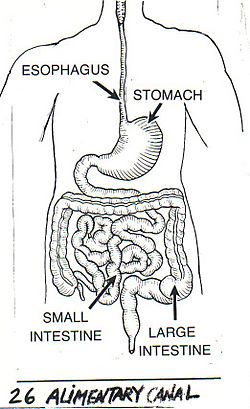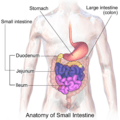Alimentary canal facts for kids
Quick facts for kids Human gastrointestinal tract |
|
|---|---|
 |
|
| Diagram of the Alimentary Canal | |
| Latin | Tractus digestorius (mouth to anus), canalis alimentarius (esophagus to large intestine), canalis gastrointestinales (stomach to large intestine) |
| System | Digestive system |
The gastrointestinal tract (digestive tract, digestional tract, GI tract, GIT, gut, or alimentary canal) is an organ system within humans and other animals which takes in food, digests it to extract and absorb energy and nutrients, and expels the remaining waste as feces.
The mouth, esophagus, stomach and intestines are part of the gastrointestinal tract. Gastrointestinal is an adjective meaning of or pertaining to the stomach and intestines. A tract is a collection of related anatomic structures or a series of connected body organs.
The gastrointestinal tract contains trillions of microbes, with some 4,000 different strains of bacteria having ddifferent roles in maintenance of immune health and metabolism.
The time taken for food or other ingested objects to transit through the gastrointestinal tract varies depending on many factors, but roughly, it takes less than an hour after a meal for 50% of stomach contents to empty into the intestines while total emptying takes around 2 hours. Emptying of the small intestine takes between 1 and 2 hours. Finally, transit through the colon takes 12 to 50 hours with wide variation between individuals.
All bilaterians have a gastrointestinal tract. This is a tube that transfers food to the organs of digestion. In large bilaterians, the gastrointestinal tract also has an exit, the anus, by which the animal disposes of feces (solid wastes). Some small bilaterians have no anus and dispose of solid wastes by other means (for example, through the mouth).
Images for kids
See also
 In Spanish: Tracto gastrointestinal para niños
In Spanish: Tracto gastrointestinal para niños


